Chevrolet
Traverse Front Brake Pads Replacement Guide
How to replace the front brake pads on a
2009 to 2016 GM Chevy Traverse crossover with picture illustrated instructions.
By Paul B. Michaels Author & Photographer Auto Mechanic Since 1989 |
||
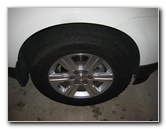 Traverse Front Wheel |
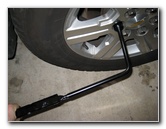 Loosen 6 Lug Nuts |
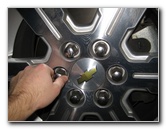 Raise Vehicle, Remove Nuts |
| This
automotive "how-to" guide was specifically written to assist owners
of the 2009, 2010, 2011, 2012, 2013, 2014, 2015 & 2016 GM Chevrolet Traverse crossover
SUV in replacing the front brake pads. Owners of other General Motors vehicles from GMC, Saturn, Buick, and Cadillac such as the Acadia, Terrain, Sierra, Yukon, Savana, Outlook, Verano, Regal, Lacrosse, Encore, Enclave, Spark, Sonic, Cruze, Malibu, Impala, Camaro, Equinox, Tahoe, Suburban, Colorado, Avalanche, Silverado, ATS, XTS, CTS, SRX, and Escalade may also find these DIY instructions to be helpful. The tools needed to complete this front brake job include a floor jack, jack stands, a tire iron, a 13mm socket with ratcheting wrench, and a "C" or "F" clamp. A few compatible aftermarket front brake pads include the following with their part numbers: Wagner QC1169A, Raybestos PGD1169AC, Bendix D1169ACT or RD1169A, Wearever PNAD1169A, ACDelco 14D1169ACH and the Akebono ACT1169A. |
||
|
|
||
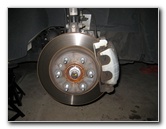 Front Rotor & Caliper |
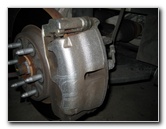 2 13mm Bolts On Rear |
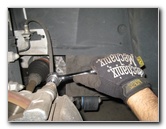 Loosen Upper Caliper Bolt |
| The first two steps
are to engage the emergency/parking brake and chock the rear wheels to
prevent it from moving. Then slightly loosen the 6 lug nuts on the front wheel with the tire iron. Raise the front of the vehicle with the floor jack and securely support it with two jack stands. Spin off the 6 lug nuts, set them aside in a safe place and pull off the front wheel. |
||
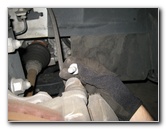 Remove Upper Bolt |
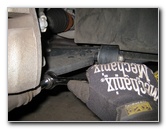 Loosen Lower 13mm Bolt |
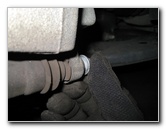 Remove Lower Caliper Bolt |
| Remove the two caliper bolts by turning them clockwise (as seen from the outside of the vehicle) with a 13mm socket and ratcheting wrench. | ||
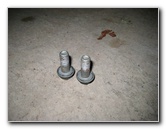 Two 13mm Caliper Bolts |
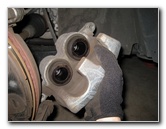 Pull Off Brake Caliper |
 Rest On Suspension |
| Pull the brake
caliper out of the bracket and carefully rest it on the suspension or tie it
up with some twine. Try to avoid stressing the rubber brake fluid hose. |
||
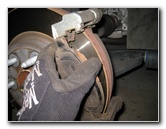 Remove Outer Pad |
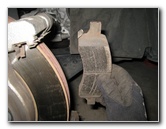 Wear Bar - Top Inner Pad |
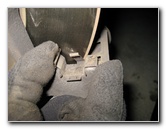 Anti-Rattle Abutment Clips |
| Remove the old
brake pads from the caliper bracket. Make a mental note of how the wear
indicator or "squeal" bar is orientated. The wear bar on this 2012 Traverse
was situated at the top of the inner pad. I recommend buying the Wagner ThermoQuiet QC1169A brake pads since they have great reviews on Amazon. I also like how they don't require any backing plates, shims or disc brake quiet gel due to the built in insulators. If your new set of front brake pads came with new metal anti-rattle pad abutment clips, pull the the old ones out of the caliper bracket and install the new ones. Thoroughly clean off the brake rotor, caliper bracket, brake caliper assembly and the lug nut studs with brake parts cleaner spray. Do not use compressed air or blow with your mouth to clean off the brake parts since breathing in brake dust can be harmful to your health. Brake dust can be carcinogenic (causes cancer) if inhaled.
To remove the existing rotors and install new ones, just remove the two bolts on the rear of the caliper bracket that attach it to the steering knuckle. Then loosen the old rotor with a rubber mallet, pull it off, and slide the new one in its place. |
||
|
|
||
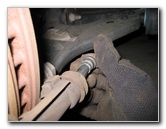 Pull Out Caliper Pin |
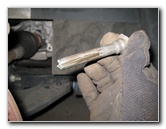 Inspect & Lubricate |
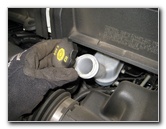 Remove Brake Fluid Cap |
|
In order for the brake caliper to work properly the two caliper slider pins need to be well lubricated. Pull the upper and lower caliper pins out of their rubber dust boots and apply a thin layer of high pressure / temperature synthetic disc brake caliper grease. Push the caliper slider pins back into their rubber dust boots until the boots snap into place over the metal lips at the ends of the pins. |
||
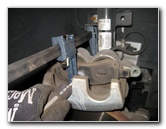 Compress Caliper Pistons |
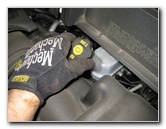 Replace Fluid Reservoir Cap |
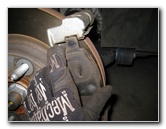 Install New Brake Pads |
| In order for the
brake caliper to fit over the thicker new brake pads, the two caliper pistons need to be compressed backwards by using a "C" clamp. Attach the "C" clamp to the caliper using the back of an old brake pad to evenly distribute the force across the pistons. Before you begin compressing the pistons, move to the engine bay and twist off the black and yellow brake fluid reservoir cap located closest to the driver's seat. Removing the cap will allow the brake fluid to more easily travel backwards through the brake lines. Repeatedly check the level in the brake fluid reservoir while slowly compressing the caliper pistons to prevent it from overflowing which may damage any painted surfaces. Compress the pistons until they are flush with their rubber dust boots. Promptly replace the brake fluid reservoir cap since brake fluid is hygroscopic (absorbs moisture). |
||
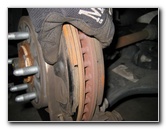 Push Pads On Rotor |
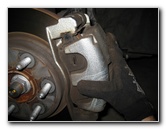 Lower Caliper Into Bracket |
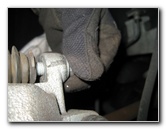 Insert Upper Caliper Bolt |
| Insert the new
brake pads into the caliper bracket with the wear indicator bar situated at
the top of the inner brake pad.
If your new brake pads didn't come with a wear indicator bar, pull the bar off the old inner pad and install it on the new pad. Push the new pads together until they are flush against the rotor. Carefully lower the brake caliper over the new brake pads while lining up the bolt holes in the caliper with the corresponding bolt holes in the caliper slider pins. If the brake caliper won't fit over the new pads, you may need to compress the two pistons back a bit further. |
||
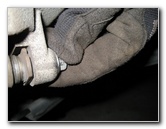 Insert Lower Caliper Bolt |
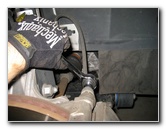 Tighten Upper Caliper Bolt |
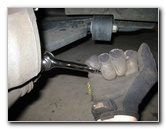 Tighten Lower Caliper Bolt |
| Insert the two
caliper bolts and thread them in a few turns by hand to prevent them from
becoming cross threaded. Tighten the caliper mounting bolts with the 13mm socket and ratcheting wrench to just past hand tight or about 20-25 ft lbs of torque. Double check that both the upper and lower caliper bolts are tight before continuing on to the next steps. |
||
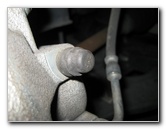 Rubber Valve Cap |
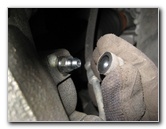 Brake Fluid Bleeder Valve |
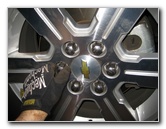 Replace Wheel & Nuts |
| If your brake pedal previously felt soft or
spongy, the brake fluid may be contaminated with water or the brake lines
may contain some air bubbles.
It would be best to bleed the brake lines at this time in order to flush out the old fluid and replace it with fresh DOT3 brake fluid. For more on this topic, check out my Brake Line Fluid Bleeding With An Assistant DIY Guide or alternatively the Brake Line Fluid Bleeding With A Power Bleeder Guide. |
||
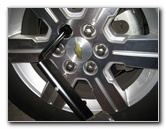 Slightly Tighten Lug Nuts |
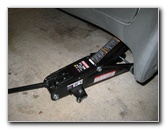 Lower Vehicle From Stands |
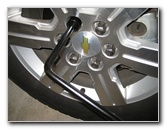 Tighten Lug Nuts |
| Replace the front
wheel, spin on the 6 lug nuts and slightly tighten them with the lug nut
wrench. Lower the vehicle from the jack stands using the floor jack and allow the front wheel to hold some of the vehicle's weight. Progressively tighten the six lug nuts in a "criss cross" or "star" pattern to about 1/4 to 1/2 turn past hand tight. It would be best to use a torque wrench or an air gun with a torque stick to tighten the lug nuts to about 75-100 lb-ft of torque.
Sit in the driver's seat of the vehicle and pump the brake pedal a few times to restore brake line pressure. Check the brake fluid in the reservoir and verify that it is at the proper level. If it is low, add some DOT 3 fluid. To break in your new front brake pads, just drive normally for the first several hundred miles while avoiding any hard or "panic" stops which may glaze over the new brake pads and cause them to be noisy and possibly not perform as well. It's also a good idea to regularly check your driveway for drops of brake fluid which may indicate a leak, check the brake fluid level in the reservoir, and also check that the lug nuts are still tight. For more,
check out my other
Chevrolet Traverse Repair & Maintenance Guides. |
||
| If you found this guide to be helpful,
please consider making a small donation by clicking on the PayPal.com
"Donate" button located to the right of this paragraph. Thank you!
(Note: I am not a registered charity. Donations are not tax deductible.) |

